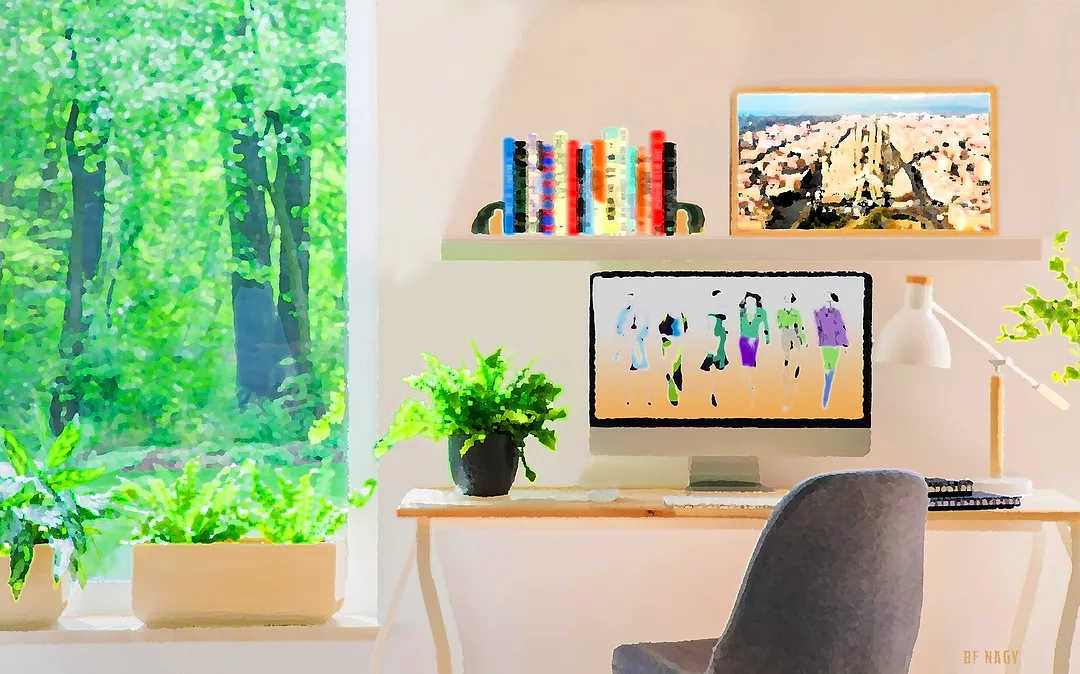Will everything soon go back to normal? Or are we going to permanently change when it comes to working at home, designing our homes and thinking about the air quality at home?
We always seem to want what we don’t have, so if we’re stuck in traffic or stuck in the office, we might wish we could work at home more. But if a pandemic keeps us there for 18 months with the kids interrupting our Zoom calls, we might start pining for the good old days in a cushy meeting room. As long as we are at home, we might ask: Is it healthy? Is it safe? Is it resilient to climate extremes?
Reports on this year’s wildfires in California and the record cold snap in Texas mentioned a few houses that still had power because their owners had added rooftop solar and batteries.
The idea of thinking the grass looks greener on the other side of the river probably led to a common metaphor to describe change: a swinging pendulum. We move in one direction, then we want a change of pace and we swing back the other way. It’s a good metaphor, but things probably don’t exactly happen that way.
Spending More Time at Home
Technology experts from IBM and elsewhere point out that the pandemic forced us to thoroughly pilot test some “new” ways, such as conference call technology, working at home and online purchasing. If and when we are less compelled to use them, we are unlikely to return 100 percent to the old way. The 18-month COVID-19 imperative has changed some things irreversibly.
Remote work experts say the pandemic accelerated an existing trend toward adopting more online meetings by at least five years and possibly 10 years. Online purchasing surged in a single year from about 13 percent to more than 35 percent and has now settled somewhere around 20 percent. It may not seem like it, but that’s a significant increase in 18 months. According to people who study demographic trends, it will only grow as younger generations expand their importance in the marketplace.
HVAC professionals say there is far greater interest in air filtration or purification at home and at school, more home renovations involving home offices, and more interest in renewables, batteries and water systems for off-grid living.
Pandemics, Other Fears and New Ways
I recently contributed content to a webinar by Triple Win Advisory in Oregon, which noted that demographics and COVID-19 are only one part of a longer list of reasons why people may wish to stay safely at home, work at home and make purchases from home.
The presentation cited fears about extreme weather events from climate change, floods, wildfires and allergies; unusual animal events such as locusts and cicadas; terrorism, racism, bullying and mass shootings; new pandemics, toxins, air pollution and algae blooms in water; oil spills, industrial explosions, nuclear radiation fears and others.
In addition to the fear of being outside, some may prefer a few of the new ways. For example, I would prefer to order my new car online rather than play the silly game that happens at old-world car dealerships. Depending on what I’m looking for at Home Depot, I might prefer to pre-order online and pick up quickly or even have something delivered.
Even for those of us who look forward to venturing out again, research suggests that travel choices might also shift. In addition to switching to electric vehicles, many may move to different ownership models such as subscriptions or vehicle sharing. That could lead to reduced car usage and more e-commerce.
Tesla will sell about 1 million vehicles in 2021, far more than anyone expected. The United States is one of the biggest growth markets for electric vehicles. Numerous subscription and car-sharing companies are springing up across North America. Most are pricey right now, but that will likely change.
HVAC designers say customers are also more interested in smart homes, smart thermostats, energy monitoring, electronics, electrification and home car chargers.
Research and consulting company McKinsey looked at 800 jobs in nine countries and concluded that hybrid models of remote work are likely to persist in the wake of the pandemic (https://mck.co/3AWFB5a). Potentially, more than 20 percent of the workforce could work remotely three to five days each week just as effectively as if they were working from an office.
“If remote work took hold at that level, that would mean three to four times as many people working from home than before the pandemic,” the November 2020 report notes.
Focus on Indoor Air Quality
Not surprisingly, the more time they spend at home, the more consumers call HVAC professionals to discuss indoor air quality. At the beginning of the pandemic, international bodies had very little conclusive research related to COVID-19 and, thus, recommended not touching each other, not sharing germs on surfaces and not coughing on each other.
As time went on and various parties studied the spread of the disease, it became clear that the virus was transmitted at least as often through the air as by droplets, shared surfaces and touching.
In April 2020, the American Society of Heating, Refrigerating and Air-Conditioning Engineers (ASHRAE) stated airborne transmission of SARS-CoV-2 (the virus that causes COVID-19) was “sufficiently likely” that airborne precautions should be taken. At the time, both the World Health Organization (WHO) and the Centers for Disease Control & Prevention (CDC) were asserting that transmission of SARS-CoV-2 was by droplet and fomite modes, not airborne.
An ASHRAE expert task force began issuing guidance documents related to ventilation, filtration, fresh air, disinfection, opening or closing buildings, and other issues.
In July 2020, 239 scientists wrote to the WHO, citing research showing the virus spreads not just in larger droplets but in aerosols, too. This was followed by an open letter from 680 built environment professionals in 51 countries, along with major industry organizations, urging public health leaders to adopt indoor air quality best practices to help protect occupants from the spread of the disease.
ASHRAE Gets More Unequivocal
Since then, the WHO and CDC acknowledged the risk of airborne transmission indoors. In April, the ASHRAE Epidemic Task Force released an updated, unequivocal statement: “Airborne transmission of SARS-CoV-2 is significant and should be controlled. Changes to building operations, including the operation of heating, ventilating and air-conditioning systems, can reduce airborne exposures."
Earlier in the year, it had released some details as follows: “ASHRAE’s Core Recommendations are based on an equivalent clean air supply approach that allows the effects of filters, air cleaners, and other removal mechanisms to be added together to achieve an exposure reduction target.”
Some additional specifics:
Ventilation, Filtration, Air Cleaning
• Use outdoor airflow rates guidance for ventilation as specified by applicable codes and standards.
• Use HEPA filters and air cleaners with MERV 13 or better levels of performance.
• Only use air cleaners for which evidence of effectiveness and safety is clear.
• Use control options providing desired exposure reduction while minimizing associated energy penalties.
Air Distribution
• Promote the mixing of space air.
HVAC System Operation
• Maintain temperature and humidity design set points.
• Maintain equivalent clean air supply required for design occupancy.
• Operate systems for the time required to achieve three air changes of equivalent clean air supply.
• Limit re-entry of contaminated air.
System Commissioning
• Verify that HVAC systems are functioning as designed.
In reviewing comments from numerous industry leaders (ASHRAE and beyond), it seems that 40 percent to 60 percent relative humidity has become a rule of thumb for contributing to indoor air safety.
Air Cleaners Debate
While ASHRAE and ventilation professionals struggled to be heard by international bodies, manufacturers responded to worldwide demand for indoor air quality solutions “guaranteed to prevent indoor airborne transmission of the virus.” Of course, making such a guarantee is discouraged by ASHRAE because it cannot yet be fully established by the evidence. Studies have been taking place, but it is all very new, and science takes time to reach anything close to conclusive recommendations.
As noted previously, ASHRAE’s first statement on air cleaners was conservative: “Only use air cleaners for which evidence of effectiveness and safety is clear.” Most commentators suggest that some air cleaners are probably helpful if people are willing to pay for them, but first steps should be adequate fresh air ventilation, humidity control, and HEPA or MERV 13 filtration.
Numerous “virus-killing” products have been introduced, many of which have been purchased by schools and institutions using government funds. Critics question claims and comment on established proven methods and priorities.
Ionization and ultraviolet light air filters are targets due to a perceived paucity of research verifying that they work. Ultraviolet lights in water systems seem to be well accepted, but in air systems, there are questions about effectiveness. In May, the International Ultraviolet Association signed a Memorandum of Understanding with ASHRAE to work together on research and tests around UV-C devices of all kinds, with the hope that a set of standards can be created.
Ionization technology makers should probably try for something similar, but it appears they have not done so yet. Criticism has ranged from calling the technology a scam to just saying it is still unproven. Rheem and some other major players introduced ionization products and my own research suggests there are likely conditions in which they work well.
According to Christian Avedon at Airius Fans, its new PureAir unit kills the SARS-CoV-2 virus. When I challenged him on it, he sent me a study from the Bulgarian Academy of Science, which conducted tests with the product. It would be wrong of me to suggest that this one study is conclusive because I’m not a scientist. But to an untrained eye, the methodology seems to have been carefully developed and worth reading.
Dr. Ivanka Nikolova writes at the end of the document: “Based on the research, it can be scientifically concluded that the air and surfaces purification system … after 60 minutes of operation in a room achieves a reduction of viral saturation from HCoV OC43 — respectively from SARS-Cov-2 with not less than 98.4 percent.”
I will leave it to the HVAC professional community to draw its own conclusions. If anyone would like me to send the PDF, please email me at [email protected].
ASHRAE’S Most Recent Pronouncement
On Jan. 21, the ASHRAE task force issued a more detailed guidance document titled “In-Room Air Cleaner Guidance for Reducing COVID-19 in Air in Your Space/Room.” It repeated much of the foregoing but included this statement about UV-C used in air systems and ionization: “These technologies are designated by CDC as emerging technologies without an established body of evidence reflecting proven efficacy under as-used conditions.”
ASHRAE’s task force (https://bit.ly/3mcO0eP) continues to issue COVID-19-related guidance documents in 2021, including: “Guidance for Small Temporary Dining Structures,” “Laboratory One Page Guidance,” “Practical Guidance for Vaccine Refrigerated Transportation and Storage Abstract,” and “Ventilation for Industrial Settings During the COVID-19 Pandemic.”
A recent Harvard Business Review article cites a 2015 study by Nicholas Bloom and coauthors that found work at home policies increased productivity by 13 percent to 22 percent.
“Companies can save on real estate costs, hire and [use] talent globally, mitigate immigration issues and experience productivity gains, while workers can enjoy geographic flexibility,” the report says. This suggests that for some companies and some employees, there are good reasons for continued working-from-home policies.
Smart building professionals will be ready to help people make the work transition from office to home, with sensible advice, knowledge and understanding of their challenges and motivations. Those who do will likely be rewarded.





